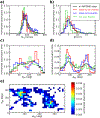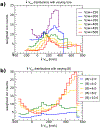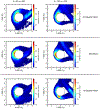Solar Wind and Interplanetary Magnetic Field Influence on Ultralow Frequency Waves and Reflected Ions Near the Moon
- PMID: 33505828
- PMCID: PMC7837449
- DOI: 10.1029/2019ja027209
Solar Wind and Interplanetary Magnetic Field Influence on Ultralow Frequency Waves and Reflected Ions Near the Moon
Abstract
With no global magnetic field or atmosphere, the Moon was traditionally seen as a perfect absorber of the incoming solar wind. Recently, it has become apparent that magnetic fields with sources in the lunar crust act to reflect a significant percentage of incoming solar wind particles, which can then interact with the surrounding plasma environment and drive plasma waves. Using data collected by the Acceleration, Reconnection, Turbulence, and Electrodynamics of Moon's Interaction with the Sun (ARTEMIS) spacecraft, we look for simultaneous observations of reflected ions and 0.01 Hz waves to study the characteristics and conditions under which wave-particle resonant interactions occur. Analyzing the solar wind and interplanetary magnetic field during these observations reveals particular solar wind and interplanetary magnetic field conditions that favor the generation of these waves. We use an ion tracing program to produce reflected ion distributions for various ambient conditions. These distributions show that the conditions that lead to more ions crossing the equatorial region where ARTEMIS orbits are also those favored for wave observations. Low-frequency waves, such as those generated by cyclotron resonance with ions, can be heavily Doppler shifted, making it difficult to determine their intrinsic properties. Reflected ion distributions for the same ambient conditions as the observed waves suggest that most of the waves are intrinsically right-hand polarized.
Figures








References
-
- Angelopoulos V (2011). The ARTEMIS mission. Space Science Review, 165, 3–25. 10.1007/s11214-010-9687-2 - DOI
-
- Auster HU, et al. (2008). The THEMIS fluxgate magnetometer. Space Science Review, 141, 235–264. 10.1007/s11214-008-9365-9 - DOI
-
- Fairfield DH (1969). Bow shock associated waves observed in the far upstream interplanetary medium. Journal of Geophysical Research, 74, 3541–3553. 10.1029/JA074i014p03541 - DOI
-
- Halekas JS, Mitchell DL, Lin RP, Frey S, Hood LL, Acuña MH, & Binder AB (2001). Mapping of crustal magnetic anomalies on the lunar near side by the Lunar Prospector electron reflectometer. Journal of Geophysical Research, 106, 27,841–27,852. 10.1029/2000JE001380 - DOI
-
- Halekas JS, Poppe AR, McFadden JP, & Glassmeier KH (2013). The effects of reflected protons on the plasma environment of the moon for parallel interplanetary magnetic fields. Geophysical Research Letters, 40, 4544–4548. 10.1002/grl.50892 - DOI
Grants and funding
LinkOut - more resources
Full Text Sources
